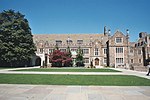Card Gymnasium
1930 establishments in North CarolinaBasketball venues in North CarolinaCollege wrestling venues in the United StatesDefunct college basketball venues in the United StatesDuke Blue Devils men's basketball ... and 4 more
Fencing venuesNorth Carolina sports venue stubsSports venues completed in 1930Sports venues in Durham, North Carolina

Card Gymnasium is a multi-purpose arena in Durham, North Carolina. It was home to the Duke University Blue Devils basketball team from its opening in 1930 until Cameron Indoor Stadium opened in 1940. During its years as home to the men's basketball team, it had a capacity of approximately 4,000. It was originally named “Duke Gymnasium” before being named after former Blue Devils head basketball coach, Wilbur Wade Card, in 1958. It currently serves as the home to Duke Wrestling and Fencing.
Excerpt from the Wikipedia article Card Gymnasium (License: CC BY-SA 3.0, Authors, Images).Card Gymnasium
Towerview Road, Durham
Geographical coordinates (GPS) Address External links Nearby Places Show on map
Geographical coordinates (GPS)
| Latitude | Longitude |
|---|---|
| N 35.997374 ° | E -78.941392 ° |
Address
Card Gymnasium
Towerview Road 320
27705 Durham
North Carolina, United States
Open on Google Maps










